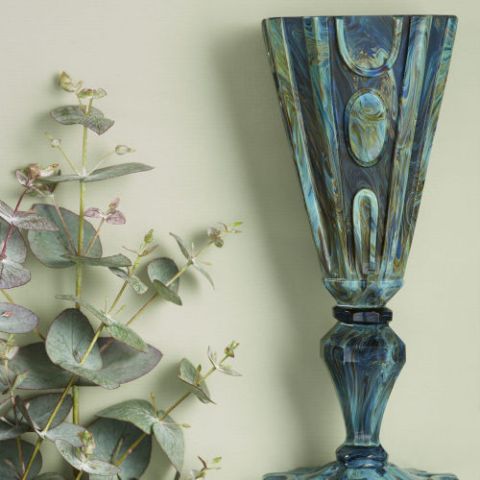
Lot was sold
Lot 1024 | Meissen | 22 FIGURINES FROM THE APE CHAPEL
Estimate
7.000
- 8.000
€
D
Result:
(incl. premium)
21.120 €
22 FIGURINES FROM THE APE CHAPEL.
Meissen.
Date: 20th century.
Maker/Designer: Models by J.J. Kaendler.
Technique: Porcelain, decorated with colors and gold.
Description: Consisting of: Transverse flutist, 4 female singers, drum bearer, monkey with drumsticks,
drummer, triangle player, violinist, bagpipe player, harpist, horn player, monkey riding
with piano, lute player, monkey with oboe, trombone player, 2 flute players, cellist,
conductor, 2 music stands.
Measurement: Height 12,5cm to 18,5cm.
Mark: Swordsmark.
Literature:
- Adams, Len and Yvonne: Meissen Portrait Figures, Leicester 1992, pp.188 and 195.
- Rückert, Rainer: Meissen Porzellan von 1710-1810. cat. no.1064-1078.
- www.meissen.com (as of 31.03.2023).
The monkey figurines, dressed in elaborate rococo clothing, parody the upper social class of the 18th century and its allures in a highly exaggerated manner. Historical records suggest that the eccentric apes were inspired in particular by the chapel of Count Brühl. The male monkeys take on the roles of the musicians, while the female monkeys are portrayed as singers.
Even though the exact date of origin of the chapel is not precisely documented, the form numbers and a purchase of 19 such figures by Madame de Pompadour suggest that the figurines were developed around 1753. Probably created by Johann Joachim Kaendler and reviewed in 1765/66 with the assistance of Peter Reinicke, the monkeys are considered the "most bizarre classic of the Meissen Baroque" (www.meissen.com).
In the middle of the 18th century depictions of monkeys, which in a parodistic way depict human traits, enjoyed great popularity. This genre of the so-called "Singerie" (French "singe" = monkey) was not only interpreted in porcelain, but can also be found in wall and ceiling frescoes or on goblins. There is a presumption that Christophe Hueet's wall paintings in the so-called monkey cabinet of Chantilly Castle may be regarded as a model for the Meissen chapel. Another French model could be a monkey chapel of the Mennecy Manufactory from the 1740s. Another example of a chapel that resembles Kaendler's models for the Meissen manufactory is an alabaster chapel from Venice, made around 1745, that today is exhibited at the Metropolitan Museum in New York.
Meissen.
Date: 20th century.
Maker/Designer: Models by J.J. Kaendler.
Technique: Porcelain, decorated with colors and gold.
Description: Consisting of: Transverse flutist, 4 female singers, drum bearer, monkey with drumsticks,
drummer, triangle player, violinist, bagpipe player, harpist, horn player, monkey riding
with piano, lute player, monkey with oboe, trombone player, 2 flute players, cellist,
conductor, 2 music stands.
Measurement: Height 12,5cm to 18,5cm.
Mark: Swordsmark.
Literature:
- Adams, Len and Yvonne: Meissen Portrait Figures, Leicester 1992, pp.188 and 195.
- Rückert, Rainer: Meissen Porzellan von 1710-1810. cat. no.1064-1078.
- www.meissen.com (as of 31.03.2023).
The monkey figurines, dressed in elaborate rococo clothing, parody the upper social class of the 18th century and its allures in a highly exaggerated manner. Historical records suggest that the eccentric apes were inspired in particular by the chapel of Count Brühl. The male monkeys take on the roles of the musicians, while the female monkeys are portrayed as singers.
Even though the exact date of origin of the chapel is not precisely documented, the form numbers and a purchase of 19 such figures by Madame de Pompadour suggest that the figurines were developed around 1753. Probably created by Johann Joachim Kaendler and reviewed in 1765/66 with the assistance of Peter Reinicke, the monkeys are considered the "most bizarre classic of the Meissen Baroque" (www.meissen.com).
In the middle of the 18th century depictions of monkeys, which in a parodistic way depict human traits, enjoyed great popularity. This genre of the so-called "Singerie" (French "singe" = monkey) was not only interpreted in porcelain, but can also be found in wall and ceiling frescoes or on goblins. There is a presumption that Christophe Hueet's wall paintings in the so-called monkey cabinet of Chantilly Castle may be regarded as a model for the Meissen chapel. Another French model could be a monkey chapel of the Mennecy Manufactory from the 1740s. Another example of a chapel that resembles Kaendler's models for the Meissen manufactory is an alabaster chapel from Venice, made around 1745, that today is exhibited at the Metropolitan Museum in New York.
Contact:
| Recommend lot |
Conditions of this Lot
VAT margin scheme, VAT included, but must not be indicated, not refundable
32% buyer’s premium on the hammer price
32% buyer’s premium on the hammer price
Estimated shipping costs for this lot:
Germany: 43,70 Euro plus 8,30 Euro VAT
EU: 58,82 Euro plus 11,18 Euro VAT
Worldwide: 117,65 Euro plus 22,35 Euro VAT
additional shipping insurance
Stock Id: 75864-1
More lots which could be of your interest
- Estimate: 2.000 - 3.000 €
15.05.2025 - ca.12:15













